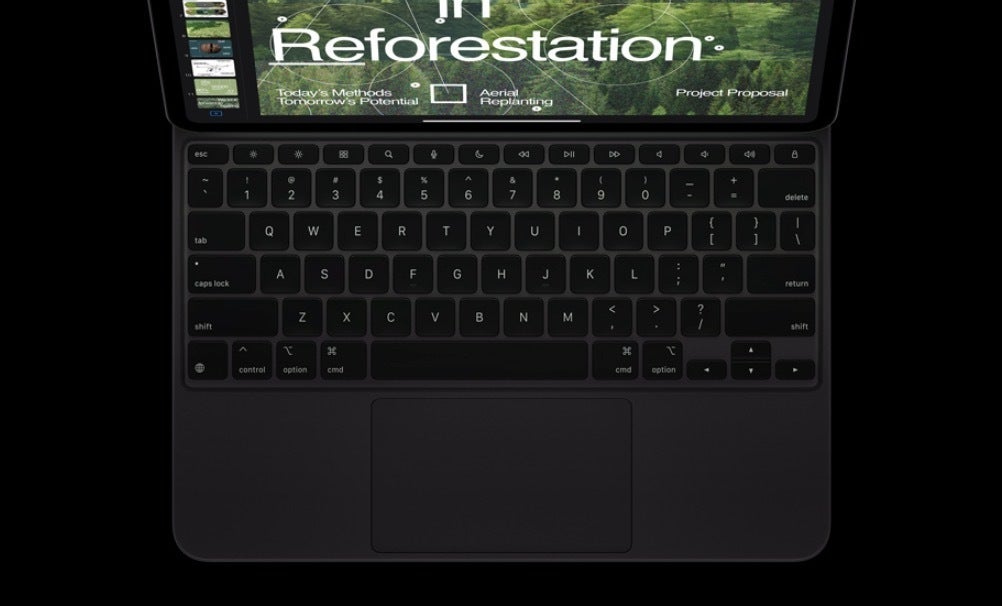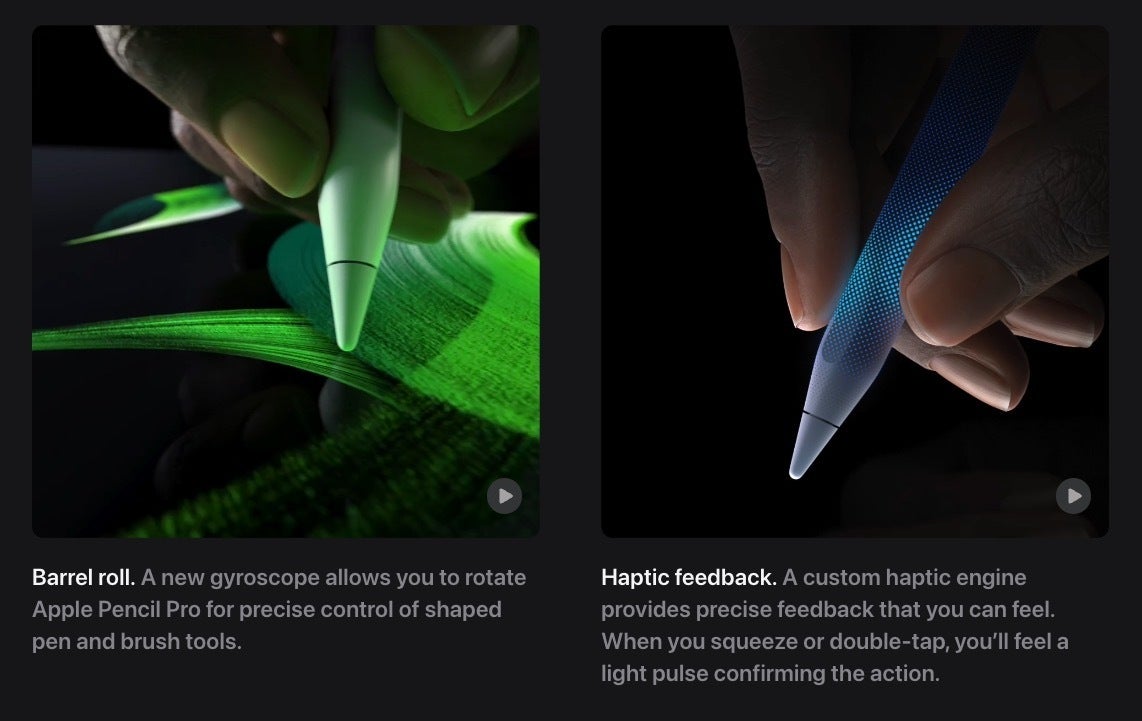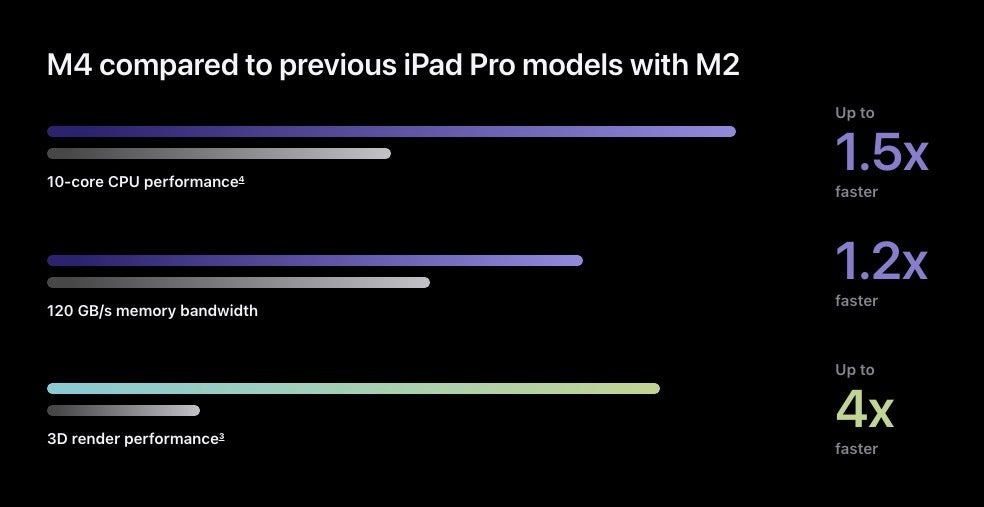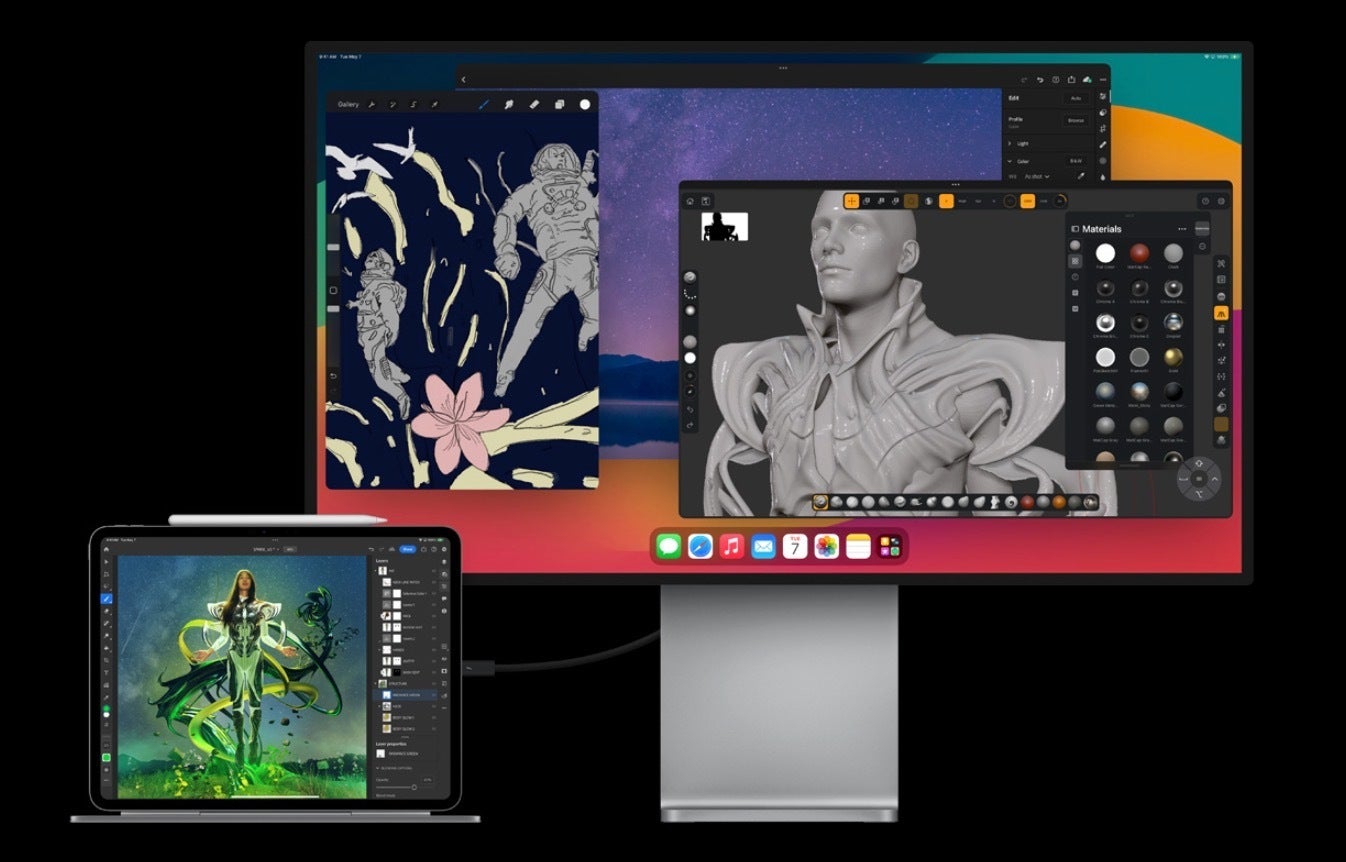iPad Pro M4 (2024) Intro
After months of waiting and false rumors, Apple has finally gone and done it — the new iPad Pros are finally here! A year and a half after the iPad Pro 11″ 4th gen and the iPad Pro 12.9″ 6th gen with its Mini LED screen first made an appearance.
And we have… uh, some upgrades to look forward to! The new Apple tablets come with OLED panels — both of them. Glorious infinite contrast and punchy colors await, but also, the Mini LED experiment seems to be over. The new tech appeared breafly in the iPad Pro 12.9″ from 2021 and 2022, and it seems Apple is dropping it like a hot potato.
- New, thinner design (iPad Pro 11 is 5.3 mm thin, iPad Pro 13 is 5.1 mm thin)
- The big iPad’s screen grows to a round 13″, from 12.9″
- Apple M4, second-gen 3 nm process
- OLED screens (tandem OLED, dual-layered)
- Selfie camera to landscape orientation
- New design for Magic Keyboard
- New Apple Pencil Pro
- Nano texture glass option (1 TB and 2 TB models)
Table of Contents:
iPad Pro M4 (2024) Specs
The king of the slabs
The iPad Pro always has supercharged hardware — enough to run desktop-class apps and console-grade games. Literally, with games like Resident Evil and Assassin’s Creed: Mirage already out for or headed for iPads with any M-class chip. But it is quite shocking that the brand-new M4 chip debuts in a tablet, instead of a MacBook.
| Specs | iPad Pro 11″ (2024) | iPad Pro 13″ (2024) |
|---|---|---|
| Size and Weight | 9.83 x 6.99 x 0.21 inches (249.7 x 177.5 x 5.3 mm) |
11.09 x 8.48 x 0.2 inches (281.6 x 215.5 x 5.1 mm) |
| Display | 11″ OLED 120 Hz ProMotion |
13″ OLED 120 Hz ProMotion |
| Processor | Apple M4, 3 nm | Apple M4, 3 nm |
| Software | iPadOS 17 | iPadOS 17 |
| Cameras | 12 MP main F1.8 ToF depth sensor 12 MP front, wide with Center Stage |
12 MP main F1.8 ToF depth sensor 12 MP front, wide with Center Stage |
| Battery Size | ~8,300 mAh | ~10,340 mAh |
| Charging Speeds | 20 W via cable | 20 W via cable |
| Prices | 8GB / 256 GB for $999 8GB / 512GB for $1,199 16GB / 1TB for $1,599 16GB / 2TB for $1,999 |
8GB / 256GB for $1,299 8GB / 512GB for $1,499 16GB / 1TB for $1,899 16GB / 2TB for $2,299 |
iPad Pro M4 (2024) Design & Colors
It’s definitely a Pro-duct
The Pro iPads, much like their iPhone counterparts, usually come in boring colors. That is Space Black and Silver — no quirky or vibrant options like on the iPad Air or the base iPad.

New keyboard, same magic (Image credit – Apple)
iPad Pro users have been envious of that base tier iPad 10th gen — it had the Magic Keyboard Folio, which had function keys — something missing from the good old Magic Keyboard for Pros. Well, no worries — Apple has taken the time to update that, too! The new Magic Keyboard now comes with function keys and a larger trackpad for a more “laptop replacement” look, feel, and function. Plus, an aluminum palm rest. All cool — unfortunately, it will only fit the new Pros. And, conversely, the iPad Pro M4 (2024) will not fit older Magic Keyboard models.
The Apple Pencil also got some love — here comes the Apple Pencil Pro. Separate purchase, compatible with both the iPad Pro M4 (2024) and iPad Air M2 (2024). It comes with a new squeeze sensor for ease of access to sub-menus, as well as a gyroscope for real-time brush and barrel roll control. And it has a Taptic engine inside to give you gentle feedback on a squeeze.


The Apple Pencil Pro (Image credit – Apple)
iPad Pro M4 (2024) Display
Tandem OLED!
It looks good… but not OLED good — there’s still some blooming observed when watching in the dark. Ultimately, the requirement to make the iPad Pros thinner, and up their image quality seems to have brought about a new strategy.
Enter Tandem OLED — the iPad Pro M4 (2024) screens are made of dual-layered OLED panels. This ensures better color calibration and much more brightness. As per Apple specs, we have 1,000 nits max brightness for SDR, and 1,600 peak brightness for HDR content. This is not iPhone levels of bright, but rest assured it’s plenty of nits!
Of course, they have 120 Hz ProMotion refresh rate and, double of course, they have a special new name — say “Hello” to Ultra Retina XDR!
As an added bonus, professionals who often work in bright environments — or outdoors — but demand excellent colors and visibility can upgrade to a nano-textured glass when buying a new iPad Pro. This option is $100 extra, and it’s only available on the 1 TB and 2 TB models — so it’s pretty pricey.
We do wish that there will be some new form of oleophobic coating on the glass panel itself. Since the introduction of the Apple Pencil, they’ve been using something that is… not oleophobic at all, even if the specs page states so — an iPad nowadays is easy to get smudgy, and hard to clean. High time to do a stealthy upgrade here, Apple.
iPad Pro (2024) Camera
It’s a tablet, not a camera


On closer inspection… something is missing (Image credit – Apple)
In reality, people don’t hold up tablets to take photos out in the park or at a show… thankfully! So, cameras are not where tablets — the iPads included — usually put a lot of focus. A good enough rear camera is required for the occasional shot or document scan. And, it seems Apple agrees. The ultra-wide camera from the back has been stealthily removed. Now, we have the 12 MP main snapper with an improved “adaptive” True Tone flash next to it for better white balance when taking photos of paper.
Thanks to the chip, you can still do 4K video at 24 FPS, 25 FPS, 30 FPS, 60 FPS, and ProRes video at 4K 30 FPS… uh, if you want to do this with a 12 MP tablet camera.
The selfie camera, as we mentioned, has now moved, so it is in a better spot when your iPad is in a landscape position (most of the time). It has the same 12 MP resolution as before, and an ultra-wide lense so it supports Center Stage — the software feature that follows your face around as you move, or widens the shot when it sees two faces enter the frame. We’ve grown to like it and prefer it after a couple of years of use now.


Top-mounted selfie camera (Image credit – Apple)
Also, the Pro iPads have the LiDAR sensor on the back — a Time of Flight camera, which enables accurate environmental scanning and placing virtual objects in your space. It gives you a better virtual ruler and better-performing AR apps and games. Though, we haven’t seen the AR trend explode, so this is still a very niche feature.
iPad Pro M4 (2024) Performance
Faster than a Mac? Can’t tell yet


No mention of how it performs next to the M3. Though, such a comparison would be hard to make, considering the M3 is slotted in bigger machines with different thermals.
But let’s get down to the nitty gritty — real life use. Looking at it… we probably won’t be using that chip to its full potential. Very few apps will need that much power, and the reward at the end will be a slightly shortened render time. That’s not a slight at the M4 chip, by the way, it’s just a testament to how good M1 and M2 were. In fact, we are still rocking 2020 and 2021 iPad Pros around the office — those A12Z and M1 chips still huff and puff well enough for medium workloads, audio work, photo and video editing.
Apple did finally launch Logic Pro and Final Cut Pro for iPads last year, and it gave them very nice updates this year. Live Multicam with up to 4 iPhones beaming imagery to a single Final Cut instance on your iPad is pretty cool. Thing is, Apple didn’t say that’s a feature exclusive to the M4 chip — only that it “works fast and flawless” on the M4. Spoiler, it’ll probably be just as fine on M2 and M1.
Logic Pro also comes with new AI features — the good old Drummer gets new band buddies — AI powered bassist and keyboards. OK, one — this is very cool. Secondly — it’ll probably come to slightly older iPad Pros, too. See, Apple did make it a point that it has been putting Neural Engine segments in its chips well before the rest of the industry started using dedicated NPUs for AI.
The point is that the iPad Pros from 2024 will have plenty of headroom for years to come. As we mentioned — we are still using 3-4 year iPads on the regular with no complaints. If you have an M1 iPad Pro, maybe you aren’t even in a hurry to upgrade, unless you want the cool new thin chassis, the new Magic Keyboard, or the new Apple Pencil Pro (or at least the Hover feature for the Pencil gen 2).
iPad Pro M4 (2024) software
The OS came with the new Journal app, a Weather app facelift, new iMessage features that make group chats easier to navigate and participate in, and new Apple Music features for shared playlists. Plus, some minor facelifts across other apps. Stage Manager is of course a huge feature here, as it gives you a desktop-ish environment to multitask and work in, when you connect an external monitor via the Thunderbolt port.


What’s a computer? (Image credit – Apple)
We did talk a bit about the new Logic and Final Cut features in the hardware section. AI was kind of brushed during the presentation — Apple made it a point to imply that old features, such as picking up a subject from the background, or copying text from a photo or live video, were already “AI features”. No bold new statements were made, and we expect a bigger AI-loaded drop during WWDC in June or at iPhone release in September.
iPads, like iPhones, receive OS updates for a good chunk of time after release — a minimum of 5 years. Apple hasn’t really came out to promise such a concrete number, but history shows us that this is the period Cupertino typically aims for. So, the iPad Pro (2024) is expected to last you this long:
- 2024 – launch with iPadOS 17
- Late 2024 – get iPadOS 18
- Late 2025 – get iPadOS 19
- Late 2026 – get iPadOS 20
- Late 2027 – get iPadOS 21
- Late 2028 – get iPadOS 22
- Late 2029 – questionable. We may or may not get iPadOS 23 here
iPad Pro M4 (2024) Battery
10 hours of solid work
Apple’s specs lists the batteries of the iPad Pro M4 (2024) as 31.29-watt-hour for the 11-inch and 38.99-watt-hour for the 13-inch. Assuming those are 3.77 V batteries, this should translate to something around:
- iPad Pro 11″ M4 (2024) battery capacity – ~8,300 mAh
- iPad Pro 13″ M4 (2024) battery capacity – ~10,340 mAh
iPad Pro (2024) Audio Quality and Haptics
As far as audio goes, we have the same quad speaker stereo setup as with the previous iPad Pros. Thus far, it has sounded excellent — you can use the iPad Pro as a multimedia machine by itself, no Bluetooth speaker necessary. We have no reason to believe that the new iPad Pros will drop in quality here.
iPad Pro (2024) Models
iPad Pro (2024) Competitors
Both ecosystems are well-developed, and both systems have their quirks, so it’s hard to say which one is definitively better. We’d say the Samsung tablets work a bit better as straight-up laptop replacers, as you can launch into DeX without needing an external monitor (which the iPad needs for Stage Manager). But, ultimately, your choice of smartphone and computer may also dictate which tablet you go for.
For example, if you use a Mac and an iPad, the Sidecar feature allows you to use your tablet as a second display, even wirelessly. Samsung has also unlocked that feature across Samsung phones, tablets, and laptops. But those are just extra conveniences — if you choose to mix brands (Android phone, Apple tablet, for example) you can still get a lot of the good stuff from both worlds.
iPad Pro M4 (2024) Final Thoughts
Are they worth it? Most definitely — we do enjoy our time with the current iPad Pros, and — as mentioned — even use the M1 units from back in 2021 excessively, with no slowdowns still. If you do spend a lot of time on a tablet, they make up for their price in value — with their performance, screen quality, sound, usability throughout a dynamic day, and software ecosystem. If you are looking for a glorified Netflix machine — an iPad Air may be the better financial decision.
👇Follow more 👇
👉 bdphone.com
👉 ultraactivation.com
👉 trainingreferral.com
👉 shaplafood.com
👉 bangladeshi.help
👉 www.forexdhaka.com
👉 uncommunication.com
👉 ultra-sim.com
👉 forexdhaka.com
👉 ultrafxfund.com
👉 ultractivation.com
👉 bdphoneonline.com